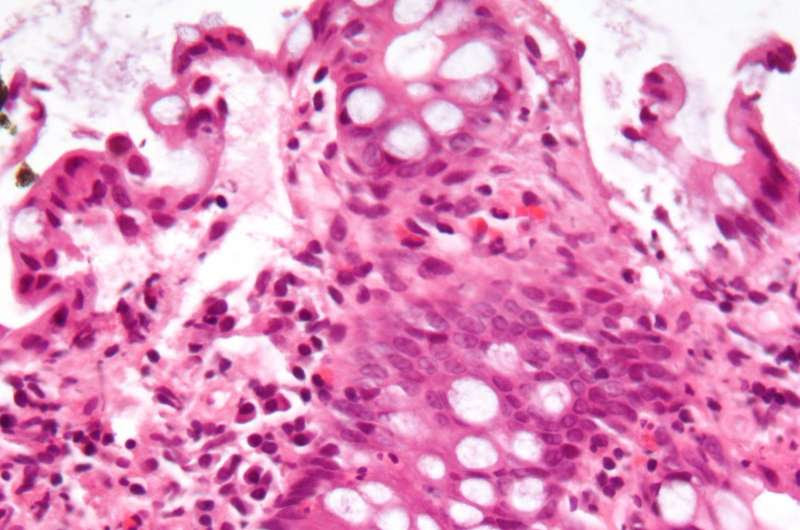by Karolinska Institutet

Micrograph showing inflammation of the large bowel in a case of inflammatory bowel disease. Colonic biopsy. Credit: Wikipedia/CC BY-SA 3.0
A research group at Karolinska Institutet in Sweden has analyzed how certain immune cells known as innate lymphoid cells (ILCs) develop into mature cells that play a part in inflammatory bowel disease (IBD). The findings could pave the way for more effective treatments against IBD, a disease that causes considerable suffering and that is linked to an increased risk of colorectal cancer. The results are published today in the journal Science Immunology.
Inflammatory bowel disease (IBD) is characterized by a chronic inflammation of the gut mucosa that is thought to increase the risk of colon cancer. The disease often debuts before middle age with symptoms such as abdominal pain and weight loss. The cause is unknown but genetic, environmental and immunological factors are all believed to play a role. As a large group of IBD patients do not respond to available treatments, there is a great need for new knowledge about the mechanisms driving the disease.
ILCs are lymphocytes, a family of immune cells, found in the mucosa where they form part of the immune system and maintain tissue function, such as the production of mucous. Previous research has shown that ILCs change function during inflammation, making them a promising target for IBD treatment.
In the present study, the researchers isolated ILCs from the tonsils and gut tissue of patients who had undergone resection surgery or endoscopic examination. A total of 48 patients were involved in the study, 31 of whom had IBD. The ILCs were then examined in detail, both immediately after isolation and after cell culture.
The results show that a subgroup of ILCs constitute a pre-stage of mature ILCs and accumulate in the intestinal mucosa of patients with IBD. Factors in the gut environment can then influence the metabolism of the immature ILCs, stimulate increased cell division and production of cytokines, including IL-22, which helps to protect the intestinal tissue.
“The function of ILCs changes during inflammation and therefore ILCs represent a promising therapeutic target for conditions like inflammatory bowel disease,” says the study’s first author Efthymia Kokkinou, doctoral student at the Department of Medicine, Huddinge at Karolinska Institutet. “Insight into how these cells develop from immature cells into mature cells in tissue helps us understand how they influence tissue function or inflammation in mucosa and how they can be manipulated for therapeutic purposes.”
The research group now hopes to study if the presence and properties of immature intestinal ILCs can predict responses to medical drugs, particularly those containing the active substances ustekinumab, infliximab and tofacitinib, which are currently used to treat Crohn’s disease and ulcerative colitis, two of the most common IBDs.
“These studies are important since the right choice of effective treatment can reduce both personal suffering and societal costs,” says Jenny Mjösberg, associate professor at the same department at Karolinska Institutet and the study’s senior author.

Leave a Reply